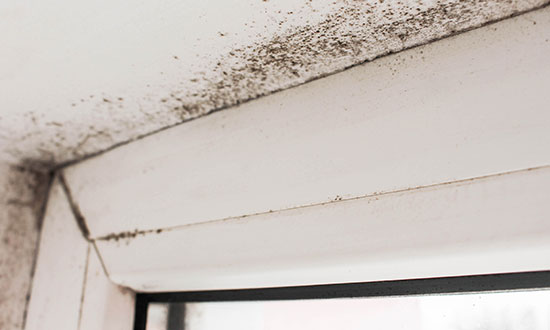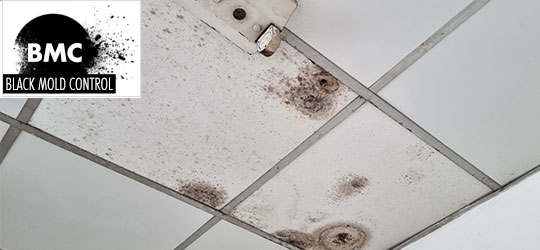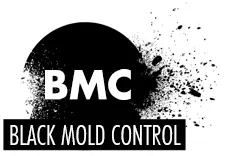Have you found black mold in your apartment? If your answer to this question is yes, you need to know what steps to take immediately to protect both your living space and your health. Black mold in your apartment can pose a serious risk to you. To ensure that you do not live near or with this dangerous fungus, you should always remain on guard for it and act quickly and assertively if you find it.
Table of contents

What causes mold?
Water, humidity and moisture cause it to grow. If you fail to clean up spilled water under a leaky pipe, for example, you create ideal conditions in which black mold can grow. Likewise, if you do not turn on the ventilation fan or open a window when you take a hot shower, you can cause fungal growth in your bathroom.
Black mold can also grow inside of the walls, ceilings and floors in your rental unit from air conditioner leaks, for instance, or if precipitation gets inside of them and does not dry up completely. It thrives in wet and moist conditions and can continue to spread if the wetness and moisture are not dried and cleaned up thoroughly.
Is black mold dangerous?
Black mold is very dangerous, especially to people who suffer from respiratory conditions like asthma. It can cause symptoms like:
- Eye irritation
- Skin rashes
- Wheezing
- Nasal congestion
It can cause pneumonia and internal organ damage in people who have underlying health conditions that compromise their immune systems.
If you suffer from these conditions when you are inside of your apartment, you may have reason to suspect that black mold is growing somewhere in it. By eliminating it, you may relieve these symptoms and improve your health.
Where to check for mold in your apartment?
When you lease an apartment, you need to know where to look for black mold growing inside of it. By recognizing what areas of your apartment can be most susceptible to moisture, humidity and wetness, you can look for signs of mold growing in them.
Technically, however, black mold can grow anywhere in the place. During the time that you live there, you should examine every part of it to find out if it is growing anywhere in it. If you find it, you should report it immediately to your landlord so it can be treated and eliminated promptly.
Recommended article: How to identify black mold
Bathroom
The bathroom in your home is one of the prime areas where this dangerous fungus can grow. Especially if your bathroom does not have a ventilation fan or a window that you can open to let in dry air after showering, it can become the ideal habitat for spores to take root, thrive and spread rapidly.
Even if you have a fan or window to use to dry out the room, you should still look for signs of this fungus. You can suspect its presence, for example, if your bathroom smells musty. You can also confirm it if you see areas of what looks to be black dirt or sludge growing along the toilet base, in corners of the ceiling or floor or under the cabinets or closet.
Depending on its extent, you may be able to get rid of it on your own by spraying diluted bleach on it and then scrubbing it with a sponge. If it has grown extensively in the bathroom, it is best for you to report it to your landlord for proper testing and remediation. Recommended article: black mold in bathroom.
AC and air vents
The air conditioner and air vents where you live can also be ideal places for this detrimental fungus to grow and thrive. The air conditioner, for example, creates water while it runs. If water from it drips into your apartment or results in condensation on the outside of your AC unit, it can cause deadly black fungus to grow in your apartment.
Likewise, the air vents in your apartment can get wet from precipitation or from water that comes from the AC unit. You may never think to look inside of your air vents and clean up any water that is inside of them. This lack of attention to your air vents can result in mold growing in them. The vents can then blow out spores that land on and cause fungus to grow in other parts of your apartment. Recommended read: mold in air ducts.
Walls and ceilings
The walls and ceilings in your rental unit can likewise become havens for this fungus to take root and grow rapidly. If they become infested with it, they can exhibit a number of tell-tale signs to which you should pay immediate attention. These signs can include discoloration of ceiling tiles, water stain-like marks on the walls and even bowing or bending of tiles and wallpaper.
If you see these signs in your ceilings and tiles, you need to act quickly to determine if they are infested with this type of fungus and how extensive the infestation is. As a tenant, you have the right to take pictures of these damages and include them in a written request for your landlord to come and check them out immediately. The pictures can be important to have on hand if you need to take legal action because your landlord did not or refused to address the problem for you.
Black mold in a rental apartment
As a tenant, you have the right to expect your landlord to provide you with a safe and clean place in which to live. You also have the right to inspect every inch of your rented space for signs of this dangerous and detrimental type of fungus.
In fact, apartments are just like any other type of residence and can become infested with spores that easily take root, spread and thrive in the right conditions. Even more, your landlord may not even be aware of the problem until you bring it to his or her attention.

Regardless, you have rights as a tenant to expect this type of problem to be addressed right away. If you did not cause the problem to start in the first place, you may be entitled by law to have your landlord have the place tested and treated for it at his or her own expense.
What are your tenant rights?
Most cities and states do not actually have tenant laws that actually require landlords to inspect their rental units for this type of fungus. However, most tenant laws do require landlords to provide safe and sanitary places for tenants to live. With that, any type of fungal infestation may fall under those tenant laws, thus requiring landlords to address such problems in a prompt and professional manner.
If you did not cause the fungus to crop up and grow in the rental unit, you are not obligated to get rid of it. The landlord must either remediate the problem on his or her own or hire a remediation company to come in and clean it up for you.
When to report black mold to the health department?
You should report it to the health department if you begin to suffer serious health consequences from it. The health department may want to test it to find out how toxic that it is and from what source it originated. It also may want to find out how extensive the problem is in the building in which you lease your home. Link to contact EPA via the online form or postal mail.
Finding mold in your apartment as homeowner
If you own your apartment, you have no landlord to which to report this serious problem. You may need to pay for remediation services on your own, especially if your homeowners association does not cover this type of damages in your agreement with it.
You may also be able to clean some or all of it up yourself. Make sure you wear goggles and gloves if you decide to use bleach and a sponge to clean up mold in your home by yourself.
Testing for mold in apartment
A professional remediation company can test your home for fungal growth. Even if you suspect its presence, you can confirm this problem by having a professional service test your home for it. It can identify what kind is growing in your home, what may have caused it and how extensive the issue really is. It can also treat and eliminate it for you. Recommended article: mold inspection and testing.
How to remove black mold from your apartment
If you decide not to use the services of a professional remediation company, you may be able to get rid of it on your own. Regular household bleach is effective in killing and getting rid of all kinds of fungus.
You may find it best, however, to dilute and spray the bleach on the affected area and then use a sponge to scrub it away. You should wear eye goggles, gloves and even a respirator mask to avoid coming into contact with the spores.
